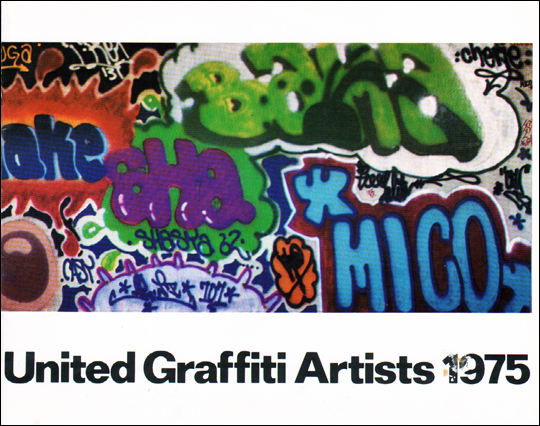
Exhibition catalogue published in conjunction with show held September 9 - 27, 1975. Texts by Hugo Martinez and Peter Schjeldahl. Exhibition included works by United Graffiti Artists : AMRL (or BAMA) Richard Admiral, CAT 87 Juan Tapia, FLINT 707 Roberto Gualtieri, LEE 163 Thomas Lee, MICO Jamie Ramirez, PHASE 2 Lonnie Marrow, SJK 171 Anatasio Kesoglides, SNAKE I Eduardo Rodriguez, T-REX 131 Darius Dent, and WG Gary Fritz.
"... The communal spirit has become formalized by Hugo Martinez, then a design student at City College, helped organize United Graffiti Artists in 1972 'to redirect their work to legitimate surfaces. UGA has held gallery showings of 'studio graffiti,' most recently at Artists Space, a gallery at 156t Wooster Street.
A gallery spokeswoman said none of the works was sold, but Martinez said two of the exhibitors -- BAMA (Richard Admiral, 22) and PHASE 2 (Lonnie Marrow, 20), both of the Bronx -- have won art scholarships to Pratt Institute.
John de Roos doesn't think it's art.
'It's been suggested they're looking for recognition as artists. I don't think that's true. They do it as children looking for attention, not as artists looking for recognition. The mere fact they met with us -- it already did them a world of good.
Jack Stewart thinks graffiti won't survive the trip from the tunnels to the galleries.
'Putting it on canvas has really hurt. You lose the spontaneity,' he said. Stewart feels the artist needs the danger and excitement of painting on the side of a train, so 'it's almost like a miracle why you see it go by.'
Martinez partly agrees.
'The element of danger, rebellion, is like a ritual. The excitement, the cops make it more fraught with tension. You have to psych yourself up, like for a big game.'
'All those things have to be internalized. These guys don't have to paint trains the rest of their lives.'"--Hal Davis, "Subway Graffiti -- 'Mass Transit Art' To Be Book," UPI, published in The Daily Messenger (Canandaigua, New York), December 1, 1975.